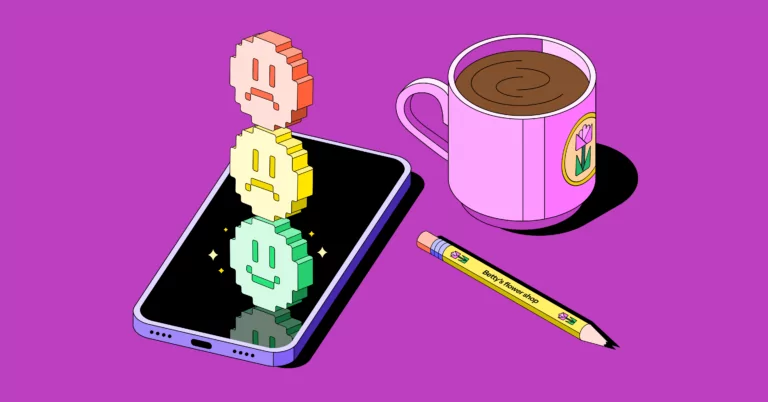Over half of customers say they’ve raised the bar on their customer service standards, and that may even be under-selling it.
The Intercom Customer Service Trends Report for 2023 reviewed things from the other angle: the perspective of customer support teams. And they say — to the tune of 83% — that expectations have gone up.
If those stats stir heart palpitations, it’s likely time for a customer service tune-up.
Read on to learn how your team can rise to the occasion and four increasingly influential factors impacting customer expectations.
4 factors behind rising customer service expectations
When your goal is to provide top-notch customer service, you need to understand what is driving surging customer expectations.
Once you know the customer service landscape and have a few ideas about meeting your customers where they are, you can keep them happy and loyal to your brand. Here are a few reasons to help you understand why expectations are so high:
1. Those dang robots! Customers expect AI to expedite customer service
Customers are hip to evolving technology.
They know businesses can employ bots, AI, and machine learning tools to simulate a good customer experience. They also think something that can give you a recipe or a vacation itinerary in seconds should be able to get them the help they need from your business just as rapidly.
Even if you’re not using AI chatbots to generate your messaging, you can automate workflows that send auto-reply text messages to customers who reach your voicemail. That’s what the Awesome Website Guys, website designers for small businesses, did.
Or you can be like Carry, a low-cost, same-day delivery service, and win back two hours from each day by automating text messages that go out to customers. With those two hours gained, they can spend more time on revenue-generating work.
Pro Tip: Automate customer service workflows to automatically push interactions from across different support channels to your customer relationship system (CRM) so your team has a single source of truth, which will help teams efficiently provide seamless customer service. For example, if your team uses HubSpot, you can set up OpenPhone’s HubSpot integration to automatically log all call recordings, voice, and text messages.
Your team can then use internal threads to coordinate a service timeline and keep everyone on the same page.
This helps your team work faster and reduces their workload while keeping customers in the loop — and saves people from repeating themselves because…
2. No one, especially customers, wants to repeat themself
Customers don’t like to have to repeat their queries. That’s an increasing frustration in the digital age, and it can be a dealbreaker. 92% of global and 88% of US consumers say they’ll spend more time with companies when they don’t have to repeat themselves.
Imagine this scenario: After an initial interaction with a support team member, a second support team member hops in and asks the customer to repeat the initial query (essentially restarting the interaction), that customer may get a “hamster wheel” feeling — and may feel like their time isn’t being respected.
When a customer finally speaks to a human rep, the customer may even feel like it’s the third time. Before reaching out to customer support, many customers troubleshoot their queries online. Oracle reports 69% of customers have tried this to some degree before they even reach out to customer service.
That’s where a modern CRM system comes to the rescue. Cornerstone Caregiving, a 24/7 on-call caregiving service, uses call recording and conversation history to keep track of clients’ ever-changing needs and questions.
Director of Development & Operations Jessie Grant says,”Instead of someone having to recollect the call that happened at two in the morning, the person who wasn’t on call can go back and listen to the customer service call recording and get filled in on exactly what happened.” Now, the team is a lot more cohesive and efficient, — and customers don’t have to repeat themselves.
Pro Tip: With custom properties in those CRMs, your team can easily personalize interactions based on information already captured.
For example, a simple custom property like “So-and-so prefers early morning meetings” can work.
3. Customers want you to read their minds
Along with remembering personal details and preferences, studies show 73% of consumers also expect companies to understand their specific needs. That number may only increase as AI improves and customer service grows more sophisticated.
Machine assistance has something to do with this expectation as well. Customers know service teams have computers where you can store the basics, like their names and preferred contact info, down to their purchase and service history. They expect the tools you use to keep you in the loop.
Remember the auto-replies the Awesome Website Guys sent to incoming callers who reached voicemail? The Awesome Website Guys team now sends more personalized text messages — something customers were demanding more and more.
Owner Logan Lenz explains, “Texting feels noninvasive, and more savvy customers appreciate that they don’t have to call.”
Pro tip: As your team provides personalized customer service, remind them that using contact notes to get up to speed is helpful. Along with using a customer’s name, listening to the customer’s concerns, and understanding the urgency of the issue, your team should track specific customer preferences by placing a note in that customer’s profile.
New customer notes can be added with each interaction, no matter how many team members the customer speaks to. Then, the next team member to talk to the customer will know the entire transaction history. This level of preparedness will help win the customer’s trust.
4. Customers expect you to keep up with the Joneses
If you saw competitors bending over backward for customers, would you? Your customers see them doing it, and they’re wondering why you aren’t.
When one business uses AI effectively, it raises the bar for all businesses. It’s the phenomenon of “expectation transfer,” as TechCrunch calls it. When a customer feels delighted by one business’s customer service, that experience becomes their new gold standard. It’s disappointing when other companies don’t meet the same standards.
For example, pet supply company Chewy continually raises the bar for pet companies, personalization, and customer service.
After Anna Brose’s dog, Gus, died last year, Chewy refunded her dog food order, asked her to donate the dog food to a nonprofit, and sent her a sympathy bouquet with a card signed by her customer service agent. The empathetic act of service went viral and cemented Chewy’s position as a customer-centric company that has amassed superfans based on its customer service.
Pro Tip: To earn your own superfans, ask, “What are my competitors doing?” Do at least that.
Then, ask yourself how you can make your customer service 20% better than your competitors. Start by considering the following:
- What sets you apart?
- What do you want to be known for?
- What do you need to implement to get there?
Do that, and your business will set the new standard.
How to meet (and even exceed) rising customer service expectations
While there are books upon books that serve as instruction manuals for running a business, this Harvard Business Journal article is a quick-start guide for keeping up with surging customer expectations. It boils down to these three recommendations for delivering a delightful customer experience:
Act with empathy towards your customers
Your team needs to tap into their lived experiences to understand where the customer is coming from: People aren’t usually calling customer service with good news. Before responding to a customer’s request, they can reflect on these questions:
- Have I ever been in a situation like this?
- How did I want to be treated?
- How did I want the issue to be resolved?
- What can I do to make this customer’s day better?
Along with this, your team can proactively do voice-of-customer (VOC) research to find out where your customers hang out, what topics they’re talking about, and what language they use when talking about those topics. AI-generated call transcripts can help your team save time completing VOC research by easily skimming and reviewing specific points of interest in any recorded call. After mapping out their entire journey with your business, you unravel what they want their experience to be.
Approach customer service holistically
Designing your customer journey involves taking a comprehensive and all-encompassing view of how customers interact with your business to ensure that every touchpoint, from pre-sale to post-sale, aligns to create a seamless and positive experience.
Also, keep in mind that happier employees provide better customer service, which results in happier customers. Your workflows should be user-friendly and take work off your team’s plates instead of adding more.
Consider how you can use the following to make touchpoints delightful for your employees and your customers:
- Self-service options so customers can help themselves, like online help centers
- Auto-replies for providing self-service information or to set expectations on when they can expect to hear back from your team
- Shared numbers so teams can share responsibility for customer calls and customer calls get answered quicker
- IVR call routing so customers are transferred directly to the recipient they want
The holistic approach is all about removing friction for everyone so they can focus more on finding solutions.
Be sincere in the humanity of your customer interactions
Customers can usually see through AI facades, so be genuine when interacting with customers. It’s best to use human interaction instead of automation to convey human emotions, like caring and empathy.
Digitally interacting with others’ emotions cheapens the experience. It’s like a teen movie from the ’90s when it turns out a crush only seemed interested because they were dared to — not because they actually were. It isn’t charming, and it’s a little bit embarrassing for everyone.
With that in mind, avoid using automation that feels impersonal, like sending generic emails that don’t relate to the customer’s situation, using chatbots with fake human-like language, or bombarding customers with irrelevant daily text messages.
Instead, to meet high customer service expectations, balance using technology efficiently and showing empathy towards customers. By letting interactions with customers reflect understanding and consideration of their unique needs, customers will have a more compelling and authentic customer experience.
Do you want to know other 2023 customer service trends so you can keep up with them, too? Learn more by reading OpenPhone’s 2023 customer service trends article.

